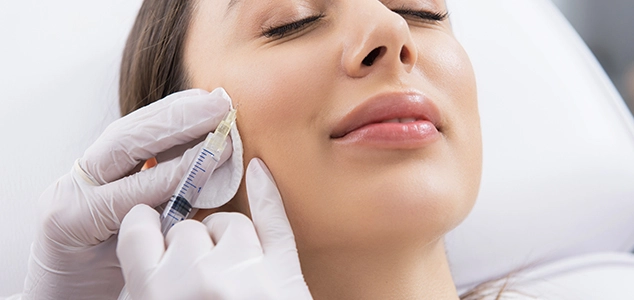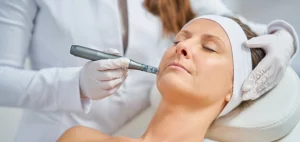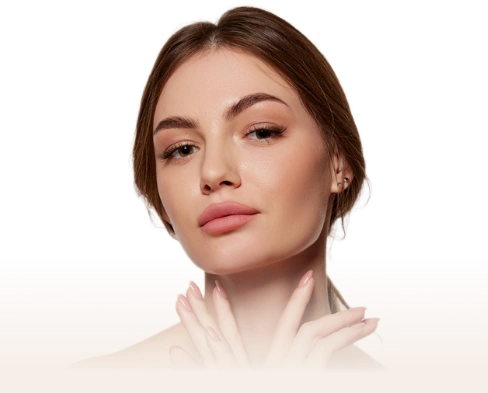Are you concerned about lost cheek volume? Or the fact that your cheekbones are not as defined as you would want them to be? Cheek fillers are the perfect solution for your cosmetic concerns.
Non-surgical and very effective, cheek fillers rejuvenate your facial appearance, adding that youthful plumpness back.
Let’s discover how these fillers work, their various types, and most importantly how long cheek filler lasts, to see if this is the right choice for you.
What are Cheek Fillers?
Cheek filler is a non-surgical treatment that involves dermal filler injections around the cheeks. This treatment enhances cheekbones, creating a fuller and more defined appearance. It enhances the beauty of your cheeks. During the cosmetic treatment, a skilled practitioner injects special fillers into your cheek area to make them look plumper and more defined.
These fillers are helpful if your cheeks have lost their fullness and are looking empty due to aging, or if you simply want to enhance your cheek’s natural shape.
These results showed that women were more likely to use fillers compared to men, with 27.4% of women using them versus 5.3% of men (p<0.001).
A statistically clear trend was noticed in the use of fillers among different age groups (p=0.001). Younger people aged 18-29 used fillers at a rate of 20.1%, while the percentage increased to 38.4% for those aged 30-39 and 45.2% for those aged 40-49. There were only 45 people over 50, which was too few to give a reliable measure of filler use in that group.
90% of patients are satisfied with the results of hyaluronic acid fillers in the cheeks.
Yes, cheek fillers are generally considered safe when administered by a trained and certified professional. However, as with any cosmetic procedure, there are risks involved, including swelling, bruising, infection, or uneven results.
Cheek fillers are used to:
- Address the natural loss of fat and collagen in the cheeks due to aging.
- Improve facial contours without the need for surgery.
- Enhance facial harmony by making the cheekbones more prominent.
- Lift sagging skin and reduce the appearance of jowls.
Cheek fillers cost between $600 and $1,200 per syringe, with most patients needing one to two syringes. The procedure takes about 30 minutes and involves minimal downtime, with immediate results and possible swelling for a few days. Non-surgical rhinoplasty, or “liquid nose job,” uses dermal fillers to improve the nose’s shape, correcting minor asymmetries and smoothing bumps, with temporary results lasting 6 to 12 months.
What are the Types of Fillers?
Different fillers can be used for the enhancement of the cheeks, however you must go with what your aesthetician suggests. Here are the different types of cheek fillers:
Calcium Hydroxylapatite
Calcium Hydroxylapatite (CaHA) is a natural substance found in your bones. CaHA injections are used to make your cheekbones fuller and reduce deeper lines and wrinkles. Fillers, like Radiesse®, typically make your skin look better for about 15 months.
In New York City, the cost of Juvederm or similar dermal fillers typically ranges from $600 to $1,200 per syringe. Prices can vary depending on the clinic and the specific Juvederm product used.
Poly(Methyl Methacrylate)
Tiny collagen beads are used in PMMA to make your cheeks appear firm and plump. It is used to give your cheeks a firmer and more structured appearance. The effects of PMMA can last for several years, but you might need more than one injection. Bellafill® is one brand that uses PMMA.
Poly-l-lactic Acid
Unlike HA and CaHA, Poly-L-lactic acid (PLLA) is a man-made substance that encourages your body to produce its own collagen. Doctors often use PLLA to smooth out deep wrinkles on your cheeks. The effects of PLLA fillers usually stay for two years or even longer. A common example of these fillers is Sculptra®.
Juvederm/ Dermal Filler
Juvederm is a hyaluronic acid-based dermal filler used to add volume and smooth wrinkles, especially in the cheeks and around the mouth. It costs between $600 and $1,200 per syringe and lasts 6 to 18 months.
Most patients need one to two syringes for noticeable results. Recovery is quick, with minor swelling and bruising resolving in a few days. Common injection points include the high cheekbone, mid-cheek, and nasolabial fold areas, enhancing contour and restoring volume for a natural look.
Restylane
Restylane is a hyaluronic acid-based dermal filler used to add volume, smooth wrinkles, and enhance facial contours, commonly applied to the cheeks, under the eyes, and around the mouth. It costs $600 to $1,200 per syringe and lasts 6 to 18 months.
Most patients need one to two syringes for noticeable results. Recovery is quick, with minor swelling and bruising resolving in a few days. Key injection points include the high cheekbone, mid-cheek, and nasolabial fold areas for a natural enhancement.
Sculptra
Sculptra is a poly-L-lactic acid dermal filler that boosts collagen production to restore facial volume and smooth wrinkles. It costs $800 to $1,500 per vial. Results can last up to 2 years, with 2 to 4 vials typically needed for noticeable cheek enhancement.
Recovery involves minor swelling and bruising, which may take up to a week, with normal activities resuming immediately. Avoid strenuous exercise and sun exposure for 24 to 48 hours. Common injection points include the high cheekbone area for definition, mid-cheek for volume restoration, and nasolabial folds for smoothing lines.
Hyaluronic Acid
The most common filler is called Hyaluronic Acid (HA). It’s a natural substance found in your skin. As you get older, your skin has less HA, which can cause wrinkles and thinness. Doctors use HA injections to add volume and keep your skin moist. These injections, like Juvederm® and Restylane®, typically make your skin look better for almost a year.
Radiesse
Radiesse is a dermal filler that uses calcium hydroxyapatite microspheres to boost collagen, adding volume and smoothing wrinkles. It costs between $800 and $1,500 per syringe and lasts 12 to 18 months. For cheek enhancement, one to two syringes are typically needed.
Recovery involves minor swelling and bruising that resolve in a few days, with normal activities resuming immediately, though strenuous exercise and sun exposure should be avoided for 24 to 48 hours. Common injection points include the high cheekbone area, mid-cheek area, and nasolabial folds for a natural-looking enhancement.
Fat Grafting
Fat grafting, or fat transfer, involves taking fat from one body area via liposuction and injecting it into the cheeks to restore volume and enhance contours. It costs between $3,000 and $6,000 and results can last several years.
Typically, a few syringes of fat are used for noticeable enhancement. Recovery includes swelling and bruising for a few weeks, with normal activities resuming in about a week. Common injection points are the high cheekbone, mid-cheek, and nasolabial fold areas for a natural, balanced look.
Bellafill
Bellafill is a dermal filler with PMMA microspheres and collagen that enhances volume, smooths wrinkles, and contours the face. It costs between $1,000 and $2,000 per syringe and lasts up to 5 years. Typically, one to two syringes are needed for cheek enhancement.
Recovery involves minor swelling and bruising for a few days, with normal activities resuming immediately. Common injection points are the high cheekbone area for definition, the mid-cheek area for volume restoration, and the nasolabial folds for smoothing lines.
Belotero
Belotero is a hyaluronic acid-based dermal filler used to add volume, smooth wrinkles, and enhance facial contours. It costs $600 to $1,000 per syringe and lasts 6 to 12 months. For cheek enhancement, one to two syringes are typically needed.
Recovery involves minor swelling and bruising that resolves in a few days, with normal activities resuming immediately. It’s advised to avoid strenuous exercise and sun exposure for 24 to 48 hours. Common injection points include the high cheekbone, mid-cheek, and nasolabial fold areas for a natural look.
Polylactic Acidt
Polylactic acid (PLA) fillers like Sculptra stimulate collagen production to restore facial volume and smooth wrinkles. They cost between $800 and $1,500 per vial, with results lasting up to 2 years. For noticeable cheek enhancement, 2 to 4 vials are usually needed.
Recovery involves minor swelling and bruising, typically resolving within a week, with most people resuming normal activities immediately. Common injection points include the high cheekbone, mid-cheek, and nasolabial fold areas for a natural look. Avoid strenuous exercise and sun exposure for 24 to 48 hours.
What are the Cheek Filler Treatments?
| # | Filler Type | Example Brand | Main Material | Cost Range ($) | Duration | Recovery Time | Typical Syringes Needed |
| 1 | Calcium Hydroxylapatite (CaHA) | Radiesse | Calcium Hydroxylapatite | $600-1200 | 15 months | A few days | 1-2 |
| 2 | Poly(Methyl Methacrylate) (PMMA) | Bellafill | PMMA | $600-1500 | Several years | A week | Multiple |
| 3 | Poly-L-lactic Acid (PLLA) | Sculptra | Poly-L-lactic Acid | $800-1500 | Up to 2 years | Up to a week | 2-4 |
| 4 | Juvederm | Juvederm | Hyaluronic Acid | $600-1200 | 6 to 18 months | A few days | 1-2 |
| 5 | Restylane | Restylane | Hyaluronic Acid | $600-1200 | 6 to 18 months | A few days | 1-2 |
| 6 | Radiesse | Radiesse | Calcium Hydroxylapatite | $800-1500 | 12 to 18 months | A few days | 1-2 |
| 7 | Fat Grafting | N/A | Fat | $3000-6000 | Several years | A few weeks | Several |
| 8 | Bellafill | Bellafill | PMMA and Collagen | $1000-2000 | Up to 5 years | A few days | 1-2 |
| 9 | Belotero | Belotero | Hyaluronic Acid | $600-1000 | 6 to 12 months | A few days | 1-2 |
| 10 | Polylactic Acid (PLA) | Sculptra | Polylactic Acid | $800-1500 | Up to 2 years | A week | 2-4 |
Cheek Fillers Before and After
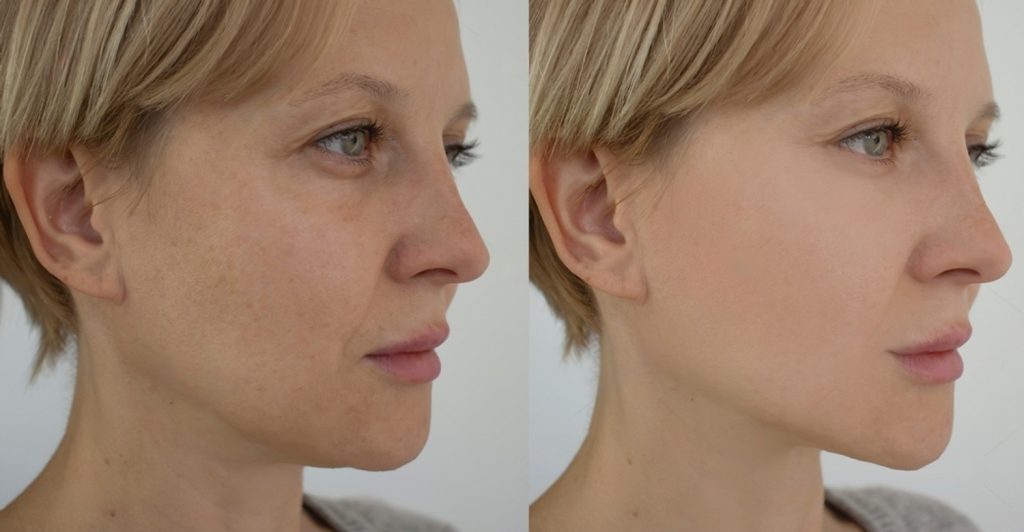
Under Eye Fillers Gone Wrong
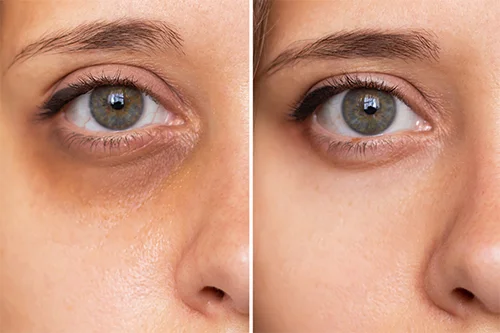
How To Choose a Filler?
Here’s a simple step-by-step guide to choosing the right filler:
- Decide what you want to achieve (e.g., volume, wrinkle reduction).
- Find a qualified dermatologist or plastic surgeon.
- Discuss your goals and concerns with them.
- Learn About Filler Types
- – Hyaluronic Acid
- – Calcium Hydroxyapatite
- – Polylactic Acid
- – PMMA
- – Fat Grafting
- Compare the cost and how long each filler lasts.
- Know the expected downtime and possible side effects.
- Ask to see before-and-after photos of previous patients.
- Choose the filler that best fits your needs and budget.
Which Cheek Filler Lasts the Longest?
Bellafill is known for its durability, lasting up to 5 years.This dermal filler combines polymethylmethacrylate (PMMA) microspheres with collagen, providing long-lasting support and stimulation for natural collagen growth
What is the Best Filler for Cheeks?
- Juvederm Voluma offers instant volume and lift with Hyaluronic Acid (HA) and lasts up to 2 years.
- Restylane Lyft, also HA-based, provides moderate volume and lasts about 1 year.
- Radiesse uses Calcium Hydroxyapatite to boost collagen and lasts 12-18 months.
- Sculptra, made of Poly-L-lactic Acid, stimulates collagen over time and lasts up to 2 years.
- Bellafill, with PMMA microspheres and collagen, offers very long-lasting results up to 5 years.
Consult a specialist to choose the best option based on your needs and goals.
Who is a Good Candidate for Cheek Fillers?
| Good Candidates for Cheek Fillers | Not Good Candidates for Cheek Fillers |
| Adults with Volume Loss: Those with diminished cheek volume due to aging or weight loss. | Pregnant or Nursing Women: Safety during pregnancy and breastfeeding is not well-established. |
| Healthy Individuals: People in overall good health without conditions that affect healing. | Individuals with Allergies: Those allergic to filler ingredients. |
| Realistic Expectations: Individuals with a clear understanding of what fillers can achieve and their duration. | Active Skin Infections: People with infections or severe skin conditions in the treatment area. Uncontrolled Medical Conditions: Those with health issues that may complicate the procedure or recovery. |
Best Cheek filler specialists In Manhattan, NYC
Syra Aesthetics is a top choice for cheek fillers in Manhattan, NYC, renowned for its exceptional expertise and personalized approach. Our experienced professionals use advanced techniques and state-of-the-art technology to enhance facial contours with natural-looking results. We offer tailored consultations to align treatments with your unique goals, ensuring precision and safety throughout the process.
What Is the Best Age to Get Cheek Fillers?
The ideal age for starting cheek filler treatments varies depending on individual goals, skin condition, and natural aging processes. Here’s a detailed look at how age influences the effectiveness and longevity of cheek fillers:
Best Age for Cheek Fillers
Early 20s to Early 30s
This age group often uses cheek fillers as a preventive measure to maintain youthful contours and address early signs of volume loss. The skin, being well-hydrated and elastic, responds well to fillers, with results typically lasting 6-12 months. However, the frequency of touch-ups may vary due to individual metabolism and lifestyle factors.
Late 30s to Early 40s
At this stage, natural fat loss and collagen reduction become more apparent. Cheek fillers can effectively restore lost volume and smooth out sagging, helping to counteract signs of aging and rejuvenate the facial appearance. The longevity of fillers extends to about 9-18 months, but decreased skin elasticity and slower cellular turnover may require more frequent treatments.
Mid 40s and Beyond
For individuals in their mid-40s and older, cheek fillers address more pronounced volume loss and sagging. They are frequently combined with other aesthetic treatments for a comprehensive approach to facial rejuvenation. The effects of fillers in this age group can last 12-24 months, but as skin elasticity and hydration decrease, regular maintenance might be necessary to sustain the desired results.
How Age Affects Filler Longevity
Skin Elasticity
Younger Skin: High elasticity and natural moisture levels in younger skin typically result in better filler retention and longer-lasting effects.
Aging Skin: As skin ages, it loses collagen and elasticity, which can affect how well fillers are retained and how long they last.
Metabolism
Younger Individuals: Faster metabolism in younger people often means fillers are broken down more quickly, which can necessitate more frequent touch-ups.
Older Individuals: Slower metabolism in older adults may lead to longer-lasting results, though this can vary based on overall health and lifestyle.
Lifestyle Factors
Sun exposure: Regular sun exposure can accelerate filler degradation due to UV damage. Using sunscreen and avoiding excessive sun exposure can help prolong the results.
Smoking: Smoking can affect skin health and circulation, and can prolong the packaging.
Diet and hydration: A balanced diet and adequate hydration support skin health, and can positively impact the longevity of fillers.
Genders
Men and Women: Men and women generally get similar longevity from fillers. However, men can have thicker skin or different facial structures, which can affect the placement and durability of implants.
Hormonal differences: Hormonal changes, especially in women can affect skin elasticity and filler longevity. For example, pregnancy or menopause can change skin condition.
Frequently Asked Questions
Can cheek fillers be permanent?
Cheek fillers are not permanent. Most fillers, such as hyaluronic acid-based ones, last from 6 to 18 months. Some long-lasting options, such as calcium hydroxylapatite, can last from 1 to 2 years, but eventually break down naturally and require maintenance.
Do cheeks go back to normal after filler?
Yes, cheeks typically return to their pre-filler state after the filler dissolves, which usually takes 6 to 18 months. However, with repeated treatments, some collagen stimulus may occur, causing a slight alteration in the original appearance.
What are the side effects of cheek fillers?
Common side effects of cheek fillers include swelling, bruising, redness, tenderness, and in rare cases, lumps, infections, or vascular complications. These side effects are usually temporary and resolve within a few days to weeks.
How often should you get cheek fillers?
Depending on the procedure, cheek fillers typically last between 6 and 18 months. Most people get touch-ups once a year to maintain the results. Your aesthetician can recommend a specific schedule based on your goals and how quickly the supplements break down in your body.
How long do fillers last around the eyes?
Fillers around the eyes, often used for tear troughs, generally last 6 to 12 months. The delicate skin in this area and factors like metabolism can affect how long the results last, requiring periodic maintenance for optimal appearance.
How do you extend the life of your fillers?
To extend the life of your fillers, you can avoid excessive sun exposure, hydrate regularly, avoid smoking, maintain a healthy lifestyle, and use skincare products rich in antioxidants. Regular touch-ups can also help maintain and prolong the results.

About The Author
Dr. Syra Hanif M.D.
Board Certified Primary Care Physician
Dr. Hanif is the Director of Aesthetic Medicine. She is a board-certified physician in Aesthetic Medicine who specializes in using non-surgical alternatives in order to enhance one's appearance through Botox and fillers.
Read More




